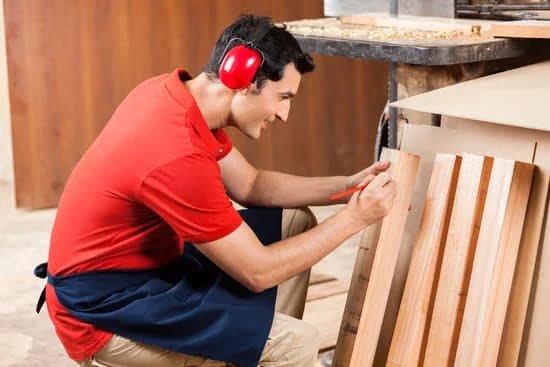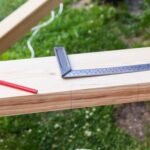What does a jointer do woodworking? A jointer is an essential tool in the woodworking industry that helps create flat surfaces and straight edges on boards. It is commonly used to prepare wood for further processing, such as joining, planing, or edge-gluing. In this article, we will explore the basic principles of jointers and their role in woodworking projects.
A jointer is a woodworking machine used to flatten the faces of rough-sawn lumber and square up one edge. It consists of a flat surface called the “bed,” over which the wood is passed, and a cutting blade mounted in the middle of the bed. The blade shaves off small amounts of wood to create a smooth and even surface. Understanding how a jointer functions is crucial for achieving high-quality results in woodworking.
In this section, we will delve into the various aspects of jointers, including their function, types, and importance in woodworking projects. Whether you are an experienced woodworker or just starting out in the craft, having a good understanding of jointers will significantly enhance your skills and enable you to tackle more complex woodworking tasks with confidence. Let’s begin by exploring the fundamental principles behind using a jointer effectively and efficiently.
The Function of a Jointer in Woodworking
A jointer is a crucial woodworking tool that plays a vital role in creating flat and smooth surfaces on lumber. It is used to straighten the edges of boards and to flatten the faces of rough-sawn lumber. This section will delve into the function of a jointer in woodworking, explaining how it works and why it is an essential tool for woodworkers.
Creating Flat Surfaces
One of the primary functions of a jointer is to create flat surfaces on pieces of wood. When working with rough-sawn lumber, the faces and edges are often uneven and may have imperfections such as twists, cupping, or bowing. A jointer’s cutting blades remove these irregularities by shaving off thin layers from the surface of the wood, resulting in a smooth and even plane.
Squaring Edges
In addition to flattening surfaces, a jointer is used to square the edges of boards. This is especially important when joining multiple pieces of wood together to create wider panels or tabletops. By running the edges of boards through the jointer, woodworkers can ensure that they are perfectly straight and at right angles to the faces, allowing for seamless glue-ups and strong joints.
Preparing Wood for Other Tools
Another important function of a jointer is preparing wood for further processing with other tools such as planers and table saws. By first flattening one face of a board using a jointer, woodworkers can then use that flat surface as a reference point when passing the board through a planer or table saw. This results in accurately dimensioned lumber that is essential for high-quality woodworking projects.
Different Types of Jointers and Their Uses
There are several types of jointers available in the market, each with its own unique features and uses. Understanding the different types of jointers can help woodworkers choose the best tool for their specific woodworking needs.
Benchtop Jointers
Benchtop jointers are compact and lightweight, making them ideal for smaller woodworking workshops or for woodworkers who need to transport their tools to different locations. These jointers typically have a cutting width of 6 inches or less, making them suitable for smaller woodworking projects such as crafting furniture pieces or creating decorative wooden items.
Power Jointers
Power jointers, also known as stationary jointers, are larger and more powerful than benchtop models. They are designed to be permanently installed in a workshop and are capable of handling heavier and wider boards. Power jointers usually have a cutting width ranging from 6 to 16 inches, allowing woodworkers to work on larger and more substantial projects.
Handheld Jointers
Handheld jointers, also referred to as hand planes or hand jointer planes, are manual tools that require physical effort to flatten and straighten wood surfaces. These traditional tools are used by skilled woodworkers who prefer the tactile experience of handcrafted woodworking. Handheld jointers are versatile and can be used for various woodworking tasks such as smoothing rough lumber, trimming edges, and leveling uneven surfaces.
Understanding the different types of jointers and their uses can help woodworkers select the most suitable tool for their specific woodworking projects. Whether it’s a compact benchtop jointer for small-scale work or a powerful stationary jointer for heavy-duty tasks, choosing the right type of jointer is crucial in achieving precision and efficiency in woodworking.
Importance of Using a Jointer in Woodworking Projects
When it comes to woodworking projects, the importance of using a jointer cannot be overstated. A jointer plays a crucial role in creating smooth, straight edges and flat surfaces on boards, making it an essential tool for any woodworker. Whether you are working on a small DIY project or a large-scale construction job, a jointer can make the difference between a professional-looking finish and a subpar result.
There are several key reasons why using a jointer is important in woodworking projects:
- Creating flat surfaces: Jointers are designed to flatten one face of a board and square up one edge, which is essential for creating stable, smooth surfaces for joinery and assembly.
- Squaring edges: Jointers also excel at squaring the edges of boards, ensuring that they fit perfectly together when joined.
- Improving accuracy: By properly preparing your lumber with a jointer, you can ensure that your cuts and joinery are precise and accurate, leading to better overall project outcomes.
In addition to these key benefits, using a jointer can also save time and effort in the long run. By starting with properly prepared boards, you can reduce the need for excessive sanding and planing later on in the project.
Ultimately, the importance of using a jointer in woodworking projects cannot be overstated. Whether you are working on cabinets, furniture, or other wooden items, incorporating this versatile tool into your workflow can significantly improve the quality and precision of your work.
Step-by-Step Guide on How to Use a Jointer Correctly
A jointer is a crucial tool in woodworking that helps to create flat, smooth surfaces on pieces of wood. Using a jointer correctly can significantly improve the quality of your woodworking projects. To ensure you get the most out of your jointer, here is a step-by-step guide on how to use it correctly.
First, you need to prepare the jointer by adjusting the infeed and outfeed tables. The infeed table should be set slightly lower than the highest point of the cutting circle, while the outfeed table should be level with the highest point of the cutting circle. This will ensure that the wood piece is properly supported throughout its entire length as it passes over the cutter head.
Next, position the wood piece against the fence and press it firmly against the infeed table. Turn on the jointer and push the wood piece forward until it reaches the end of the outfeed table. It’s important to maintain steady pressure and keep both hands firmly on the wood piece to ensure safe and accurate operation.
After passing the wood piece through the jointer, turn off the machine and inspect the surface for any imperfections. If necessary, repeat the process until you achieve a flat and smooth surface. Finally, always remember to wear appropriate safety gear such as protective eyewear and hearing protection when operating a jointer.
| Step | Description |
|---|---|
| 1 | Prepare and adjust infeed and outfeed tables |
| 2 | Position wood piece against fence and apply pressure |
| 3 | Turn on jointer, push wood piece forward, and inspect surface for imperfections |
Tips and Tricks for Getting the Most Out of Your Jointer
When using a jointer in woodworking, there are some tips and tricks that can help you get the most out of this versatile tool. Here are some valuable tips to consider:
1. Keep your blades sharp: One of the most important aspects of using a jointer effectively is ensuring that the blades are sharp. Dull blades can result in rough and uneven cuts, so it’s essential to regularly sharpen or replace them as needed.
2. Use proper technique: When feeding wood into the jointer, it’s important to use the correct technique to achieve smooth and precise results. This includes maintaining a consistent pressure and speed while guiding the wood through the machine.
3. Consider grain direction: Pay attention to the direction of the wood grain when using a jointer. It’s generally best to feed the wood against the grain for optimal results, as this can help prevent tearout and produce a smoother surface.
4. Take light passes: Instead of trying to remove too much material in a single pass, it’s advisable to take lighter cuts with the jointer. This approach helps avoid strain on the machine and produces better results by gradually smoothing and straightening the wood.
5. Test on scrap pieces: Before working on your actual woodworking project, it’s a good idea to test the jointer on scrap pieces of wood. This allows you to make any necessary adjustments and practice your technique before tackling your main project.
By following these tips and tricks, you can maximize the effectiveness of your jointer in woodworking projects and achieve professional-quality results.
Common Mistakes to Avoid When Using a Jointer
Using a jointer in woodworking can be a game-changer for creating smooth, flat surfaces on your wood pieces. However, there are some common mistakes that woodworkers make when using a jointer that can affect the quality of their work. By being aware of these mistakes and knowing how to avoid them, you can ensure that your jointer is helping you achieve the best results in your woodworking projects.
One of the most common mistakes when using a jointer is not setting the blades correctly. If the blades are not properly aligned or balanced, it can result in uneven cuts and an inconsistent surface. It’s important to regularly check and adjust the blades on your jointer to ensure that they are aligned perfectly for optimal performance.
Another mistake to avoid is trying to take off too much material in a single pass. While it may be tempting to speed up the process by taking off a large amount of wood at once, doing so can put unnecessary strain on the jointer and lead to tear-out or uneven surfaces. It’s best to take multiple lighter passes instead of one heavy pass, especially when working with hardwoods or figured woods.
Lastly, one common mistake that woodworkers make when using a jointer is neglecting proper safety precautions. Jointers can be powerful tools, and without following safety protocols, serious accidents can occur. Always wear appropriate safety gear such as goggles and hearing protection, and make sure to keep your hands and fingers away from the cutting blades.
| Common Mistakes | How to Avoid |
|---|---|
| Improper blade alignment | Regularly check and adjust blades |
| Taking off too much material at once | Take multiple lighter passes |
| Neglecting safety precautions | Wear appropriate safety gear and follow safety protocols |
Conclusion
In conclusion, the value of a jointer in woodworking projects cannot be overstated. From creating perfectly straight edges to ensuring flat and smooth surfaces, a jointer plays a crucial role in achieving high-quality results. Its ability to produce precise cuts and eliminate imperfections makes it an indispensable tool for woodworkers of all skill levels.
Additionally, different types of jointers offer versatility for various woodworking tasks, allowing for customization and precision in shaping and smoothing wood surfaces. Understanding the basics of using a jointer and following a step-by-step guide ensures that woodworkers can maximize the potential of this essential tool and produce professional-looking results.
It is important to note that while using a jointer can significantly improve the quality of your woodworking projects, it also requires proper technique and caution. Therefore, mastering the use of a jointer while also being mindful of common mistakes to avoid will help woodworkers achieve the best possible outcomes. Ultimately, investing in a quality jointer and learning how to use it correctly is an investment that pays off in producing high-quality, professional-looking woodworking projects.
Frequently Asked Questions
Do I Need a Jointer for Woodworking?
A jointer is a useful tool for woodworking, especially when working with rough lumber. It helps flatten and straighten one face of a board, making it easier to run through a planer and creating a flat surface for gluing.
What Are the 2 Main Uses of the Jointer?
The two main uses of a jointer are flattening and straightening the face of a board. By removing twists, bows, and cups in the wood, the jointer prepares it for further milling or joining.
What’s the Difference Between a Jointer and a Planer?
The key difference between a jointer and a planer lies in their functions. A jointer is used to flatten the faces of boards and square up one edge, while a planer is used to create boards of consistent thickness. In essence, the jointer prepares the wood for planning.

Hi everyone! I’m a woodworker and blogger, and this is my woodworking blog. In my blog, I share tips and tricks for woodworkers of all skill levels, as well as project ideas that you can try yourself.





